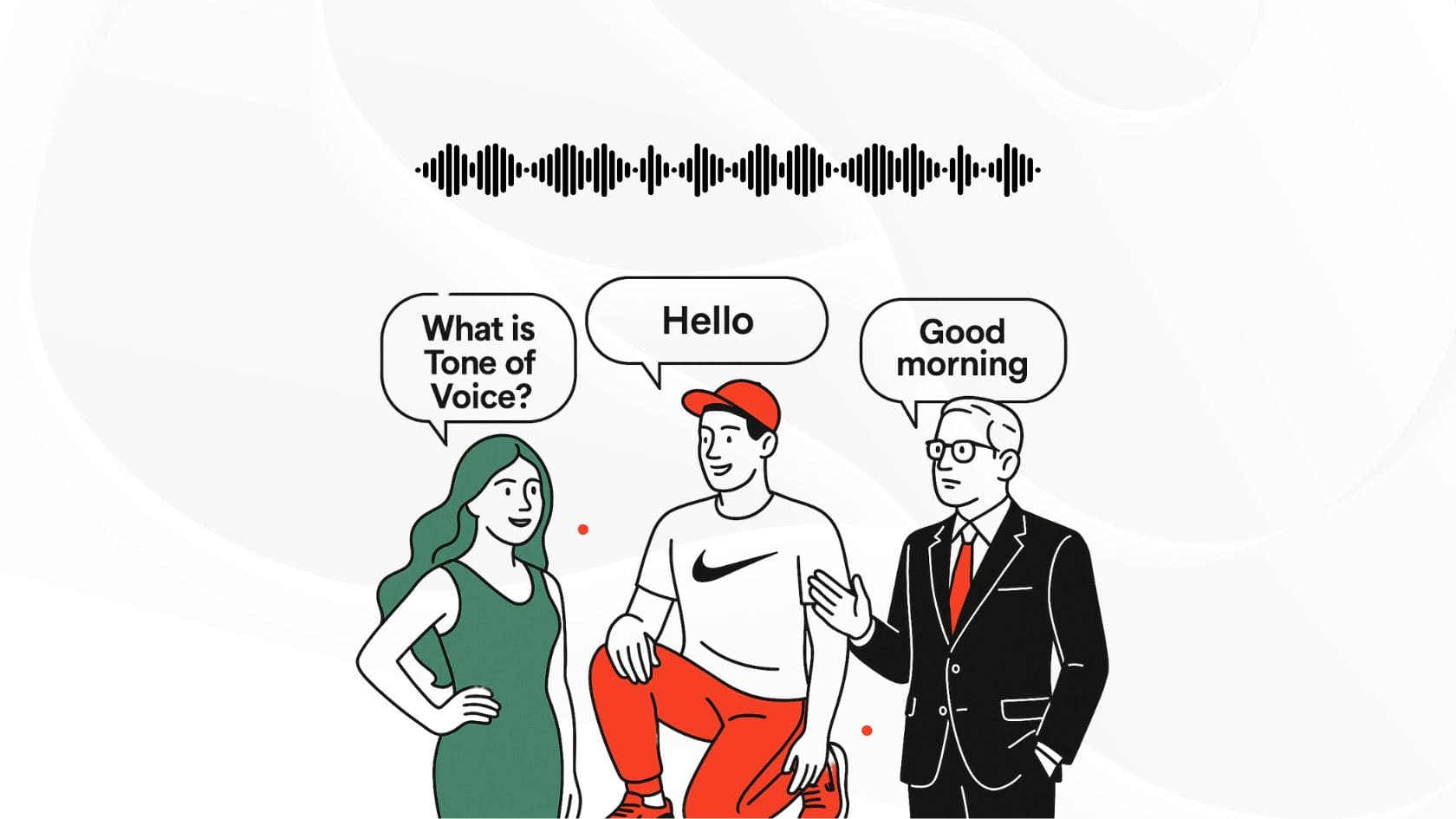
WHAT IS TONE OF VOICE?
The brand’s tone of voice is an important part of the marketing strategy. It is used across all communication channels with the target audience, in both spoken and written messages. The tone of voice is a consistent theme in user communication and should be followed by everyone in the company—from executives to service staff, from marketers to customer service managers.
What is this about?
- What is Tone of Voice and why is it important?
- Main parts of Tone of Voice
- How to find the right Tone of Voice?
- Using Tone of Voice in marketing: successful examples
- Tips for using the right communication style
- Conclusions
What is Tone of Voice and why is it important?
The brand’s tone of voice shows and expresses its brand values using words and extra symbols. In videos and phone calls, we can use facial expressions, gestures, and tone of voice. But in articles, posts, and email campaigns, we are limited to text—sometimes with images or videos. What really matters is that the team agrees on which words are important to use and even repeat in messages, and which ones should be avoided.
Internal company documents, client emails, blog articles, and landing pages—all should follow the same style. This doesn’t just mean using the same colors and fonts, which we’re already used to. It’s just as important to keep the tone consistent.
We know many companies in the same industry, speaking to similar target audiences, but using completely different communication styles. That’s because at some point, through trial and error, they figured out which tone of voice fits best with their brand style, company mission, and core values.
“Your brand’s tone of voice is how you talk to your target audience using word choice, writing style, and emotional tone.”—Develop Your Brand’s Tone of Voice, Neil Patel, Co Founder of NP Digital & Owner of Ubersuggest
A brand’s tone of voice is a consistent way to reach your audience. Along with the visuals, it helps define the brand’s identity and builds certain associations and a clear image of the company in the minds of current and potential customers.
The same sentence, said in different ways, can feel totally different. Think about how you talk to coworkers or friends—and how you text them. One emoji can change everything, right? Talking to customers also has its own nuances. That’s why AI-generated texts can’t really help with writing emails or other materials for customers. Personalization and emotion bring your message to life.
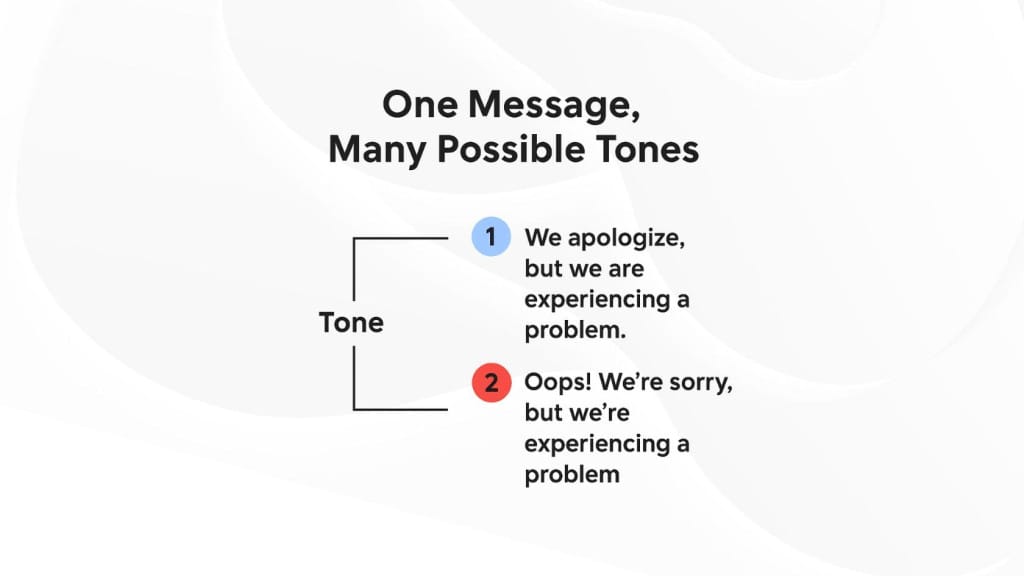
Tone of voice affects how much customers trust a company or a personal brand. If it’s chosen and used well, people will recommend the brand more often.
Imagine you bought delicious bread at a local bakery, but the saleswoman was rude and didn’t even say goodbye or wish you a good day. Would you recommend that bakery to a friend? Probably not. The same goes for e-commerce: the product might be perfect, but the friendliness of the brand often decides if people come back—and bring their friends too.
Being friendly always helps, but it’s not the only thing that matters. Many copywriters focus only on making the text short and sales-driven. But top brands follow different rules. Marketers at big companies look deeper. They study how their audience communicates and adapt to that style. On top of that, they create something unique—something that people will always connect with their brand. It might be a deliberate typo, a joke, or some other special touch. Even in serious industries like accounting or finance, a little conversational tone can go a long way.
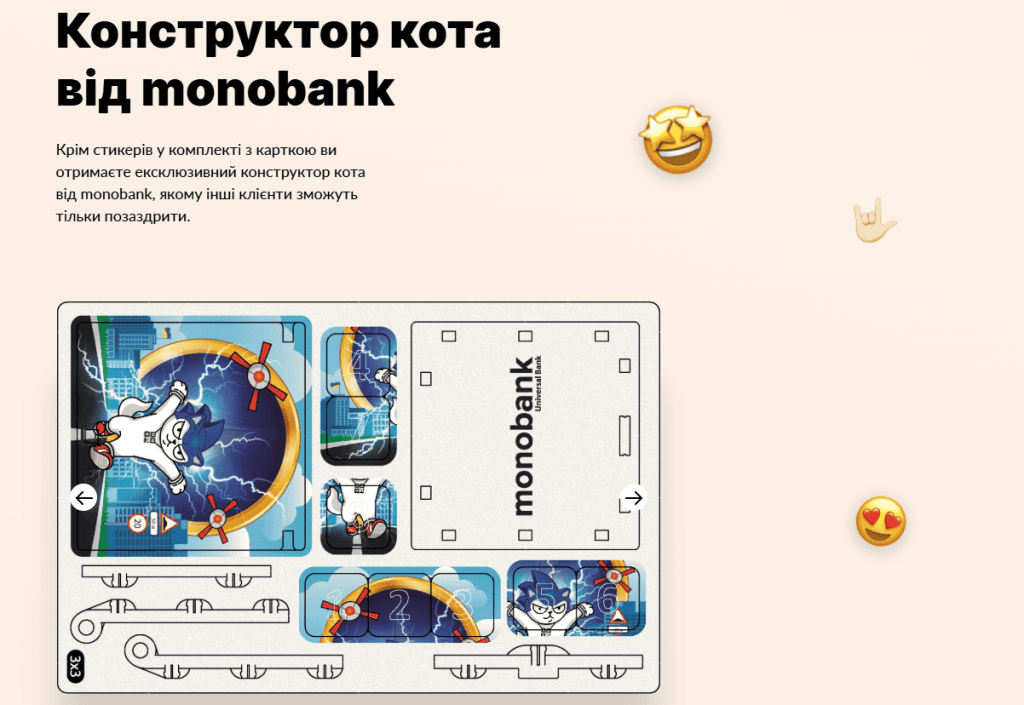
Being serious doesn’t mean being cold and formal. But humor can be tricky. Jokes that are hard to understand may annoy or push people away. Make sure your humor doesn’t get in the way of important facts, and that it fits your audience’s age and status.
The way people talk to each other affects their relationships. In the same way, a brand’s tone of voice shapes how customers feel about the company. That means tone of voice affects how well your marketing strategy works, including things like SERM (Search Engine Reputation Management).
What happens when tone of voice is used right?
- Better brand recognition. Sometimes a communication style is so strong that fans can recognize the brand from just one call to action. A slogan can even become a popular phrase outside the world of advertising.
- Standing out from competitors. Your brand’s way of speaking helps show what makes your offer different and supports the image you want to create.
- Showing company values. This matters not just for your audience, but also for your team and leadership. A brand becomes a community when it clearly shares its values, sticks to its mission, and brings people together.
- Creating an emotional connection with your audience. Good headlines, CTAs, lead form offers, and other copy support your brand visuals. You can cheer people up, inspire them—and make them want to buy from you.
- Higher profits. When people recognize and choose your brand, when they understand and support your values, and when they feel good emotions and strong associations—all that brings in more leads and more sales.
According to Edelman research, about 4 out of 5 consumers need to trust a brand before they consider buying from it. Tone of voice helps show a brand’s authenticity. You can see this both on big company websites and in influencer blogs. Natural writing—like natural images—is highly valued in a world full of fake content. So catch your audience’s vibe and speak their language.
Elements of Tone of Voice
Tone of Voice is the brand’s voice that shows up in how you communicate, write, and choose words. Every piece of text reflects this tone—even the words on buttons. That’s why it’s an important part of UX copywriting. The tone should stay the same across the website, email campaigns, and the mobile app if the company has one.
The communication style includes:
- – speaking style;
- – common words you use;
- – slang and favorite terms;
- – stop words (the ones you should avoid);
- – signature tricks (like long sentences, short phrases, or an unfinished sentence to create mystery);
- – favorite punctuation that creates tone;
- – brand emojis;
- – special greetings and sign-offs;
- – filler words and exclamations;
- – unusual vocabulary, like rare Ukrainian words or English words written in Cyrillic;
- – use of typical brand-style jokes and sayings.
It’s important to use the same tone of voice across all communication channels. If you choose a certain tone for your website and social media, use it in email campaigns and phone calls too. Prepare scripts for managers and guidelines for department leads. It’s even better if you can show the brand’s tone of voice through your personal brand—for example, during webinars, conferences, trade shows, or interviews.
You can create a tone of voice guide and review it regularly, updating it to match your target audience’s needs. Add examples of correct phrases and also incorrect ones—so your team knows what expressions and style mistakes to avoid.
Your internal guidelines should include the target audience profile, the brand’s core values, and its mission. This way, you create a communication style guide you can share with new team members—especially copywriters, marketers, and content creators.
How to find your brand’s Tone of Voice?
There are four main tone of voice qualities:
- respect;
- formality;
- humor;
- enthusiasm.
Based on that, the main tone styles are: respectful, serious, funny, and bold.
📌 Read in the article: How to define your target audience?
Types of Tone of Voice
Ask yourself a few questions and shape your unique style. Decide how much each element will show up when you communicate with your target audience.
- How respectful should you be when talking to customers? Of course, respecting customers should always be part of any brand’s values. But there are different ways to show it. A tone that’s not very respectful doesn’t mean rude—it can just mean a casual, equal-level way of talking.
- Is your communication formal and official? Or is it more conversational, relaxed, and everyday?
- Should the writer stay serious, or is it okay to show a cool sense of humor? Clever jokes can help you connect with your readers. But be careful—in some industries or specific situations, “stand-up” style jokes may not be appropriate.
- What’s the best way to talk about your product or service to get a potential customer interested? Should you keep it short and to the point, or more excited and emotional? Often, showing enthusiasm helps even when it doesn’t seem like the right moment for it.
To get accurate answers, you may need to do some research on your target audience. Look at their comments and posts on social media, run competitor audits, and brainstorm with your team. You can also reach out directly to customers and send them surveys.
After you collect the results, try to sum up your tone of voice in just a few words—for example, “caring, fun, casual” or “informative, to the point, friendly, a bit bold.”
How to choose your communication style?
To better understand how to define your brand’s tone of voice, imagine a scale with four main communication dimensions. On this scale, you move an imaginary slider to show the type of mood or attitude you lean toward—or want to show—when talking to customers. Your tone can fall at either end of each dimension or somewhere in the middle.
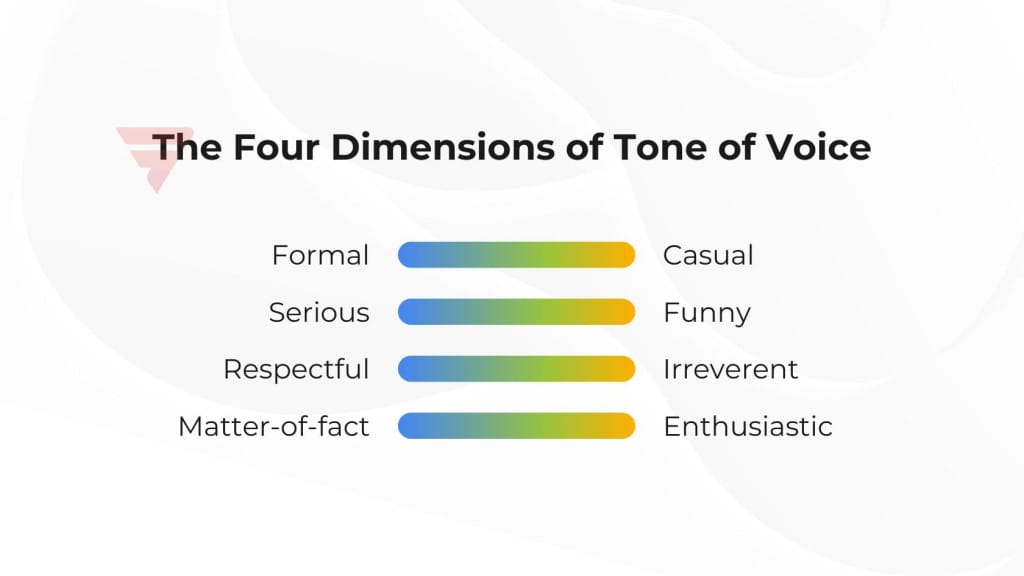
This four-dimensional space defines the tone of communication with customers—and also inside the company. The content creator’s job is to decide where each message should be on the emotional scale.
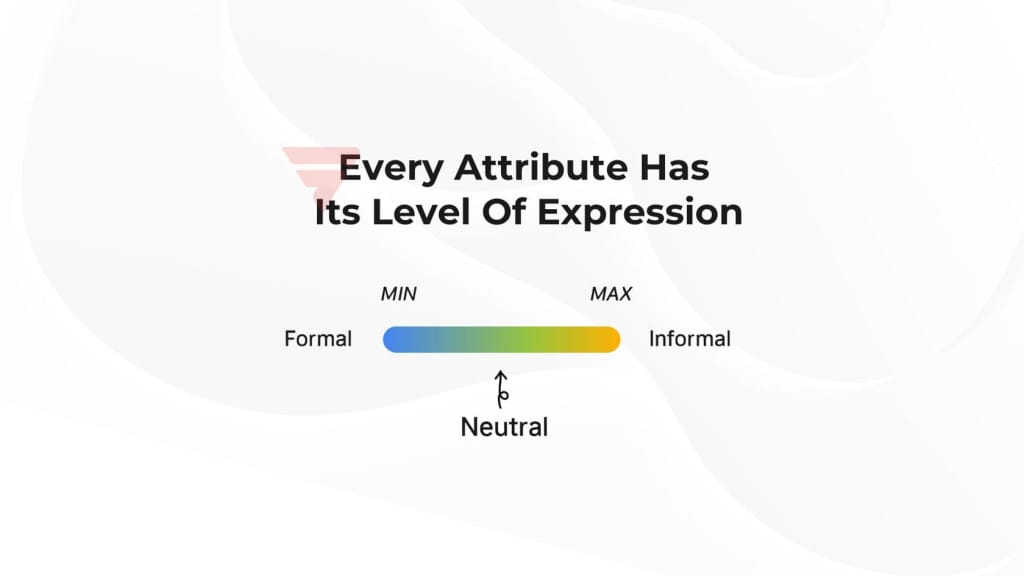
And of course, the style can shift a bit depending on the context. On an error message page, the tone might be different from an email about special offers or personal discounts. We also speak differently with friends and family depending on the situation.
Using Tone of Voice in Marketing: Successful Examples
Successful companies have a very clear understanding of how they speak to their audience. This makes their communication with customers more effective and helps boost brand recognition.
“Microsoft’s voice is how we speak to people. It’s the mix of personality, content, tone, and style.
While our voice stays the same no matter who we’re talking to or what we’re saying, we adjust our tone—from serious to caring or playful—depending on the situation and how the customer feels.”—Microsoft Writing Style Guide
The Microsoft team shares tips that can be adapted for any brand. Key advice includes: using a positive and conversational tone, choosing short and everyday words, and avoiding jargon and abbreviations.
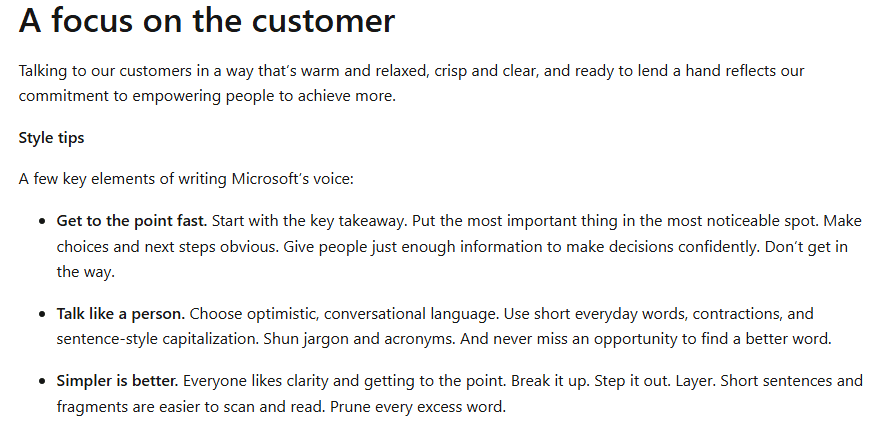
There’s a special section on Microsoft’s website that lists voice and style tips.
- Use bigger ideas, fewer words
- Write like you speak
- Project friendliness
- Get to the point fast
- Be brief
- When in doubt, don’t capitalize
- Skip periods (and : ! ?)
- Remember the last comma
- Don’t be spacey
- Revise weak writing
This list is a great example of what you can include in your own tone of voice guide. The full recommendations also explain common mistakes and give clear examples of what to do and what to avoid—even down to the small details.
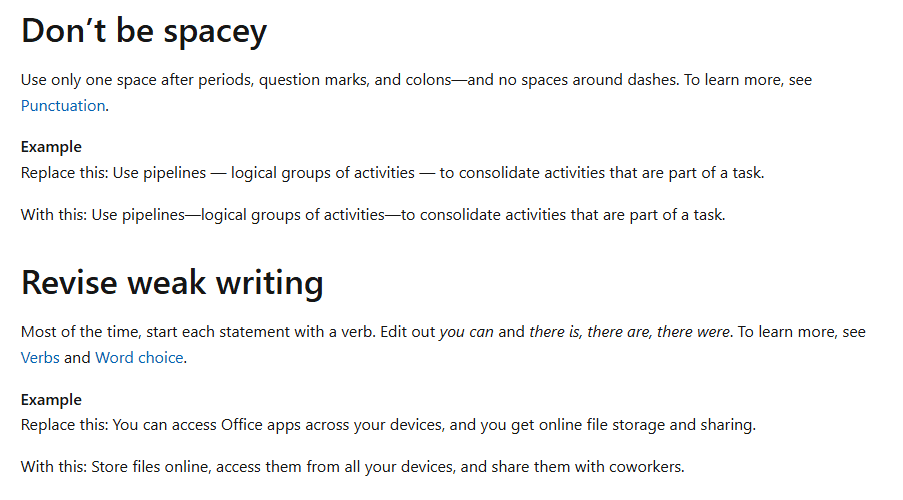
Let’s look at more examples from well-known brands that have defined their tone of voice and use it successfully
Respectful Tone of Voice
Apple
Apple has a tone that feels both innovative and refined. The brand is so famous that the word “apple” often doesn’t make us think of the fruit anymore. On its website and across customer touchpoints, Apple uses short, bold, and slightly edgy statements. The brand informs and inspires at the same time, which makes reading about technology feel far from boring.

The brand tone is casual yet serious, with enthusiasm combined with a respectful attitude towards users in almost every line. The brand uses wordplay and bold calls to action.
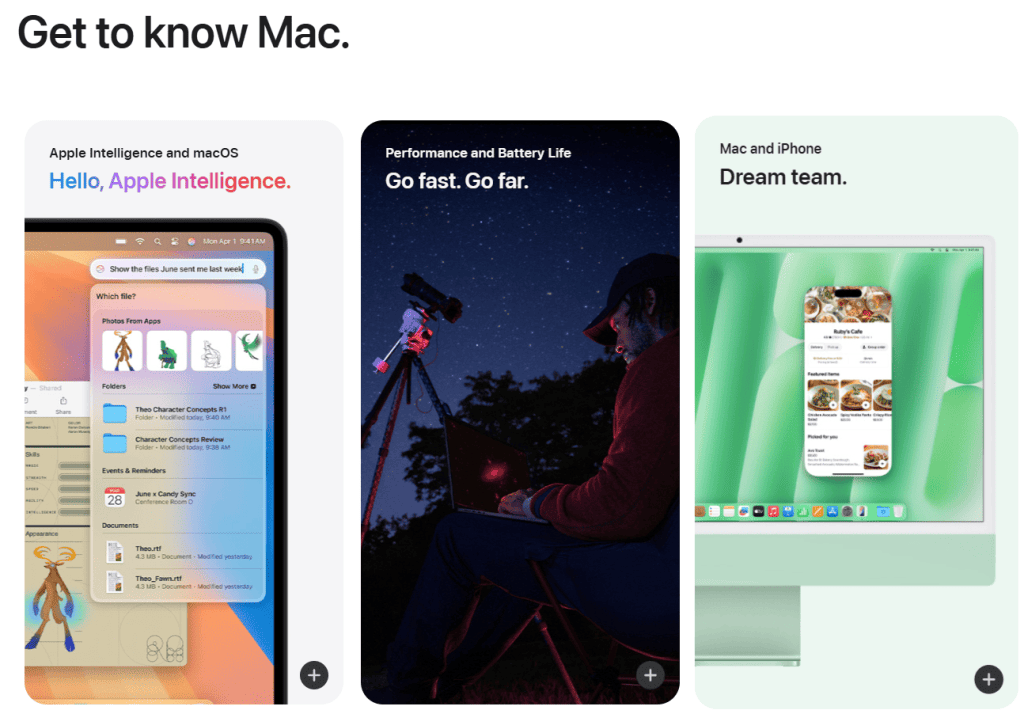
Serious Tone of Voice
Nielsen Norman Group
An American consulting company that analyzes computer interfaces, including the Microsoft operating system, and offers online courses for UX certification. The tone of voice is serious, formal, respectful, and concise—matching the professional communication style of the target audience.
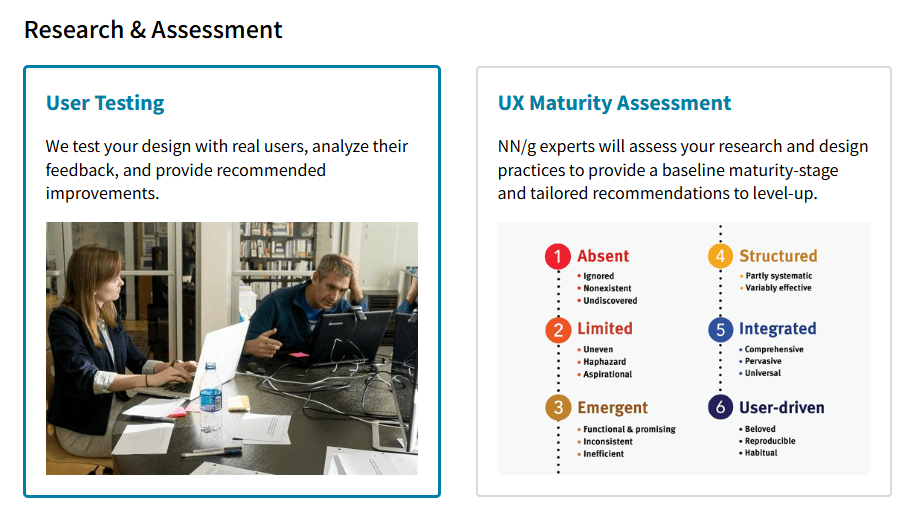
Calls to action, button texts, and other texts are very calm and short, without exclamation marks, questions, or enthusiasm.
📌 Read in the article: How to write a User Story
Forbes
The texts on the website are full of specifics and have almost no emotions. The tone toward readers and community members is respectful. This matches the Forbes mission: “To give people the knowledge, resources, inspiration, and connections they need to succeed.”

Sample text tone is defined in the Forbes Editorial Values And Standards: “Our high standards of quality and trustworthy journalism remain unchanged. As an international publisher and platform, we strive for premium storytelling, analysis, and thought leadership…”
Funny Tone of Voice
Mailсhimp
The company talks to its audience in a warm and everyday way. People feel emotionally connected to the brand. The casual tone with gentle humor feels like chatting with a good friend—someone a bit older and a lot wiser.
The company gives a great example of how a person’s tone and a brand’s tone can change.
“What’s the difference between voice and tone? Think of it this way: your voice stays the same, but your tone changes. You might use one tone when you’re having dinner with close friends, and another tone when you’re in a meeting with your boss.
Your tone also shifts depending on how the person you’re talking to feels. You wouldn’t talk to someone who’s scared or upset the same way you’d talk to someone who’s laughing.
It’s the same for Mailchimp. Our voice doesn’t change much day-to-day, but our tone changes all the time.”—MailChimp Content Style Guide
Clear explanations on how to write educational and legal content, social media posts, and clearly stated goals and principles—all this makes Mailchimp’s communication style a popular example of good Tone of Voice. Calls to action are clear and calm, while also friendly and conversational.
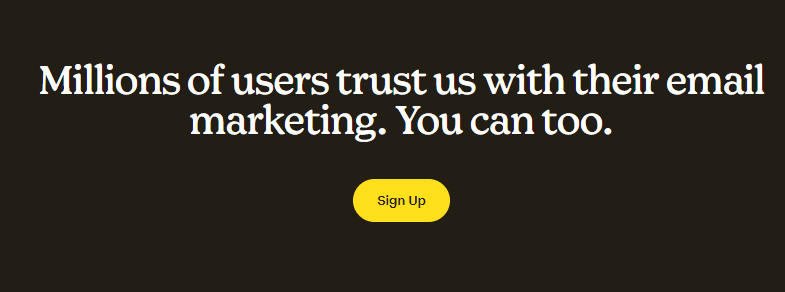
Sentences are short and explain the key things the audience cares about. This is especially clear in the FAQ section.
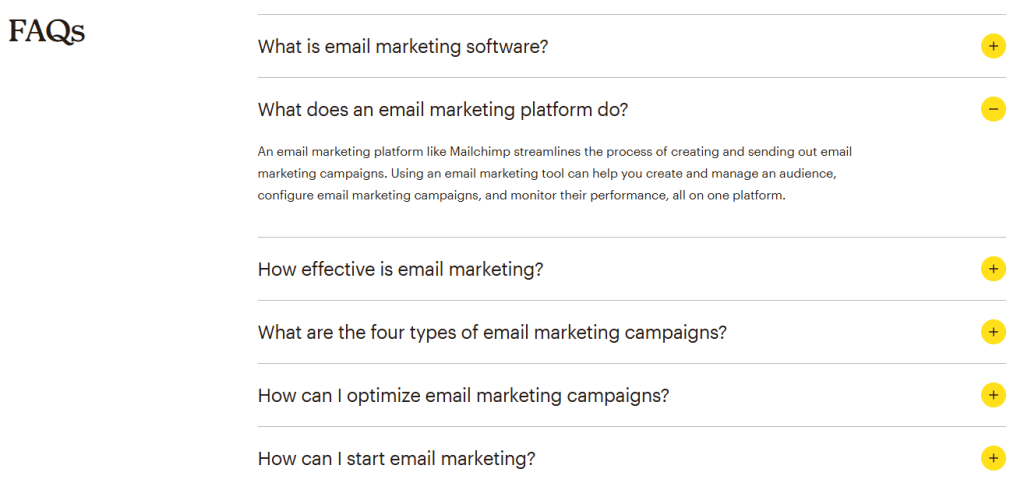
Mailchimp is funny—just enough. It uses jokes on social media. This kind of content goes viral easily, which helps grow reach and build audience loyalty.
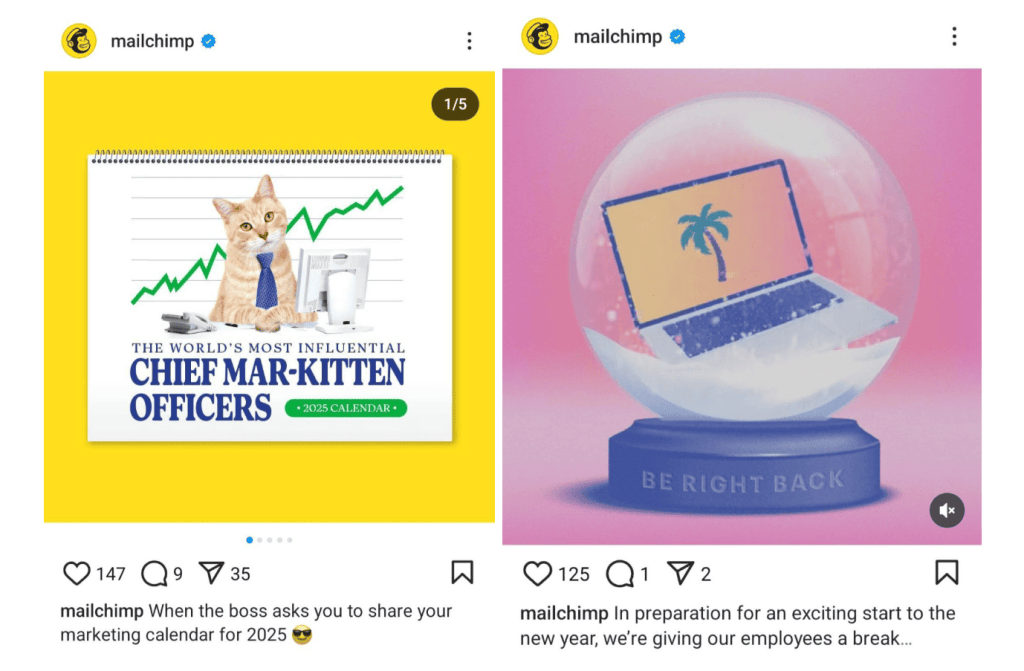
The company uses this communication style in content marketing too—like in articles and infographics.
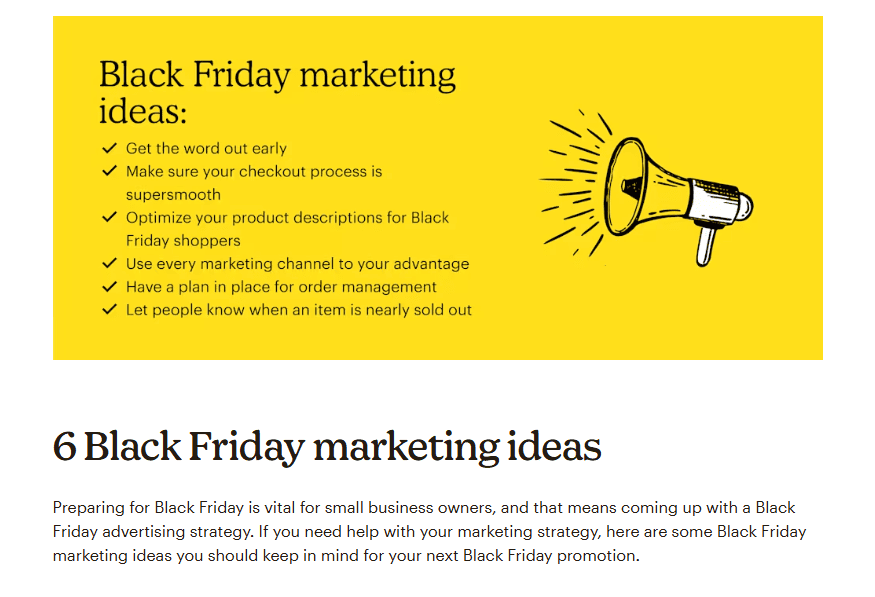
Duolingo
Having a brand character almost always makes the communication style funnier and more relaxed. Think about the owl from Duolingo. The tone of voice of this language learning service is also friendly and funny, which makes people feel like the learning process can be fun and exciting.
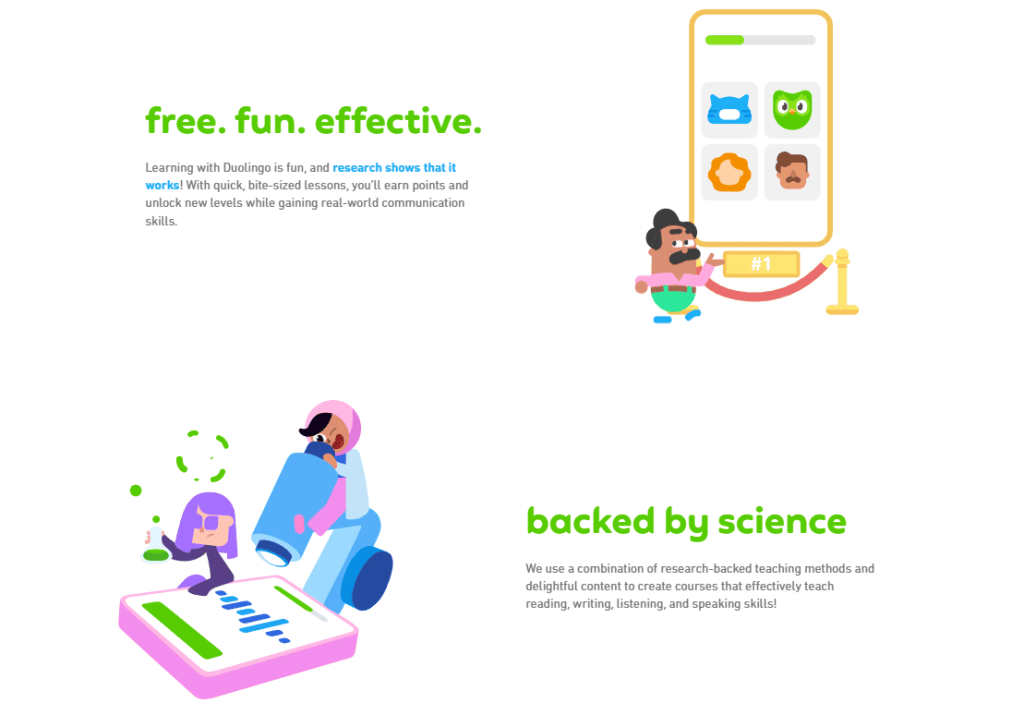
Bold Tone of Voice
ASOS
The content is lively and engaging: “At ASOS, we never settle. We’re always testing—always in beta—and constantly improving to make everything a little better each day. From easy delivery and returns to innovative visual search tech, if it hasn’t been done yet, we’ll find a way to make it happen.”
The tone of voice perfectly matches the brand’s energetic visuals and products.
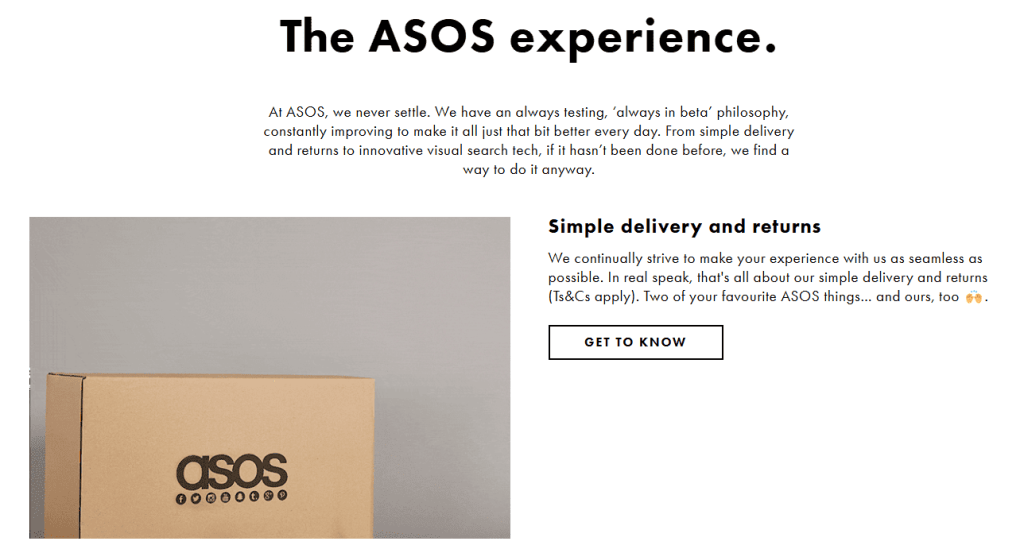
Bold statements about standing out in the fashion industry grab attention. This can make potential customers curious—is the product really that impressive, or is it just big talk? That’s exactly the kind of emotion a bold tone should spark.
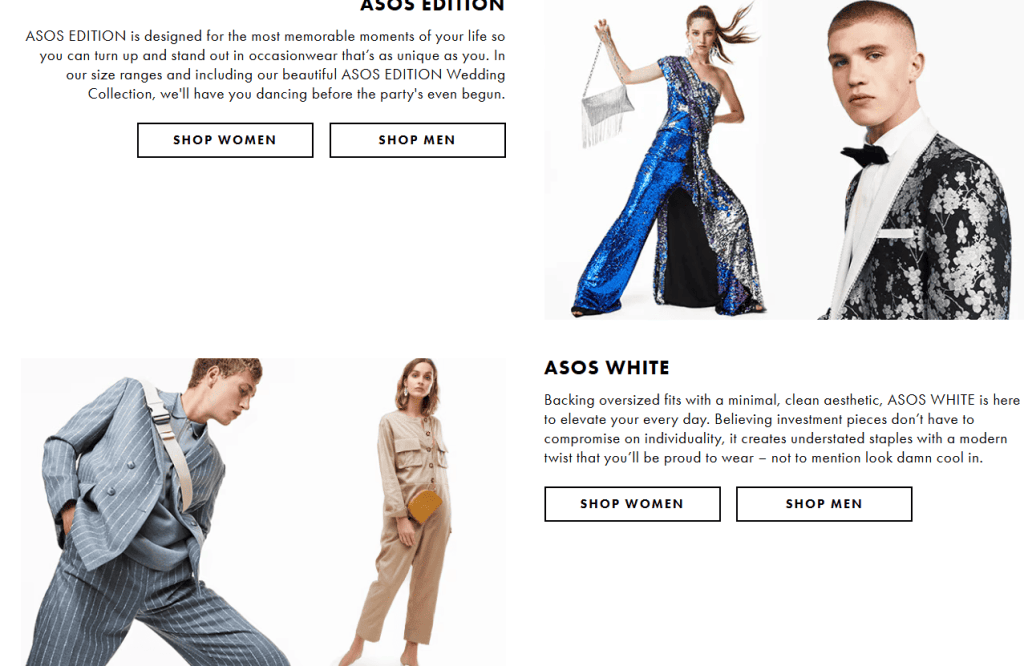
ASOS speaks directly to its young target audience without trying to please everyone. Their social media is full of short, cheeky, and clever posts.
Netflix
It’s rare to find a brand that sticks to just one tone. Most brands don’t speak in a way that’s only funny or only formal. Different channels, moments, and audience segments call for different styles. Tone of voice often shifts during a rebrand too.
Netflix shows how four main tone dimensions can work together. They might even appear on the same page.
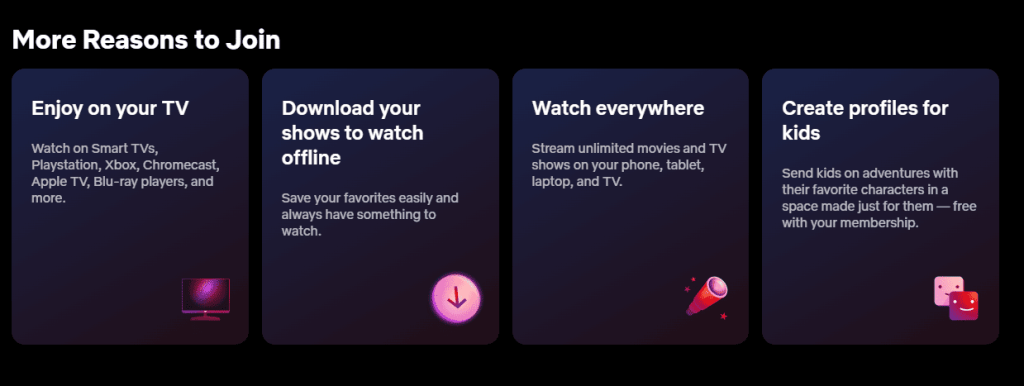
Netflix’s tone is bold, casual, a little funny, more irreverent than respectful, and full of excitement. If you had to sum it up in two words—light and easygoing. But their informative content can still be serious. So, Netflix isn’t super consistent—it switches tone depending on the context more than other brands in similar spaces.
As the platform added more features, branding—and communication—evolved. When Netflix introduced streaming, and later content creation, a big rebrand happened. The tone became bolder, more inspiring, and funnier.

KFC
KFC is similar in this way. Its tone is bold and friendly.
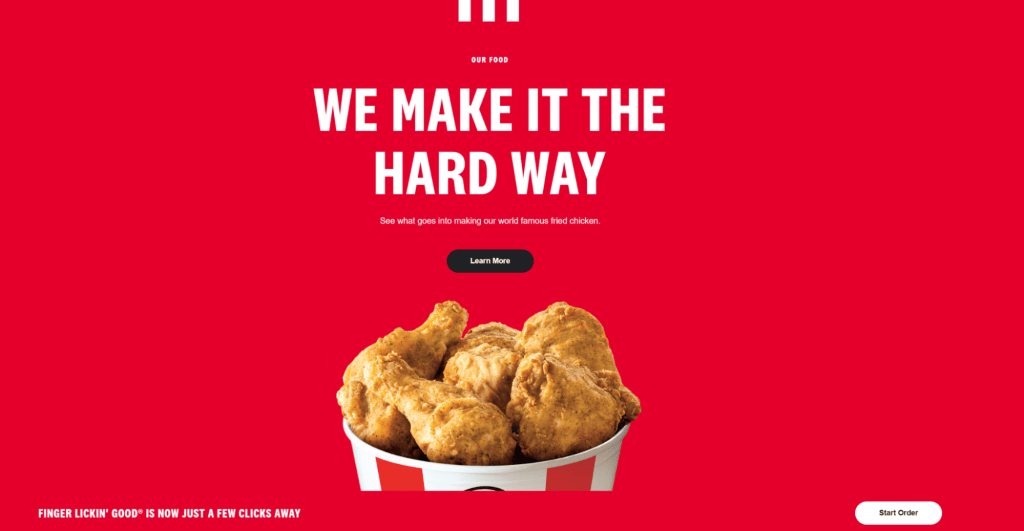
Even the company’s story on its website reads like a fairytale.
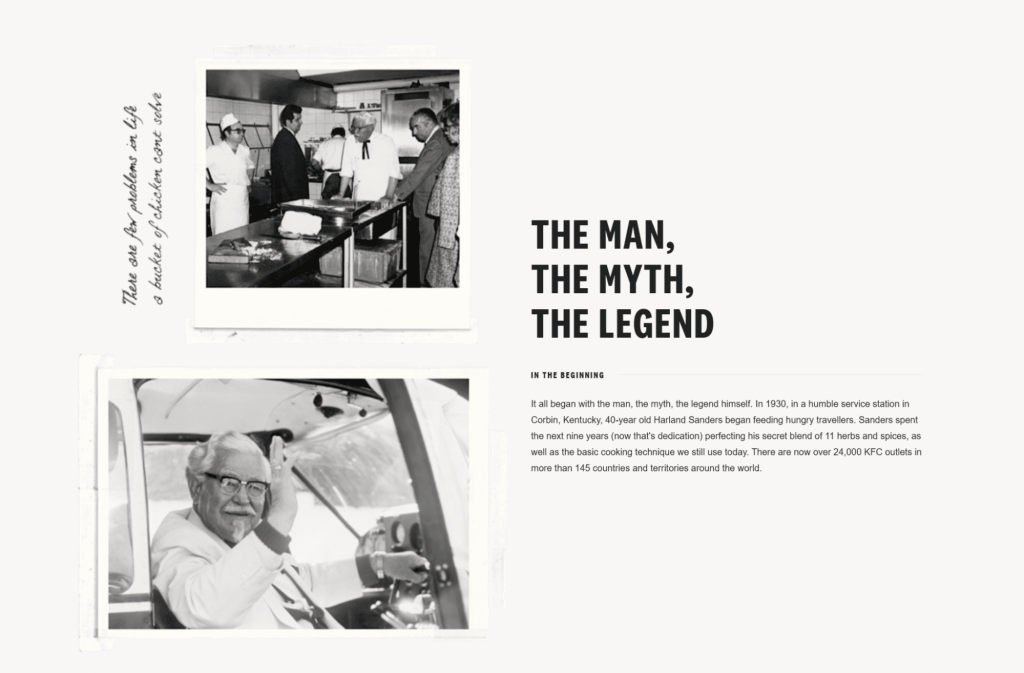
Coca-Cola
The global brand Coca-Cola has a friendly but very restrained, almost classic tone of voice.

Communication Style Tips
To define and grow your brand’s tone of voice:
- Study your target audience
- Look at your competitors (including indirect ones)
- Analyze your current messaging—maybe you already have a tone that just needs sharpening
- Check your company’s mission and values—that’s a great starting point
- Choose a few adjectives that reflect your brand voice
- Write brand tone guidelines
- Test and improve how your tone affects engagement in Google Ads and Meta Ads.
Facebook communities are a great place to learn about your audience—not just their interests, but how they talk. When reviewing how people interact on social media, look at how they form thoughts, whether they keep it short, use emojis, slang, made-up words, or English terms. Age matters too. Understanding your typical customer helps you “translate” your content into their language.
Just like with people, we prefer different communication styles from different brands. One brand feels easy to talk to, another—not so much. Your marketing goals decide what kind of tone will connect best—even punctuation can make a difference.
Conclusions
We all judge a brand’s tone of voice—often without realizing it. We choose brands that “speak our language” and earn our trust. Tone can be funny or serious, respectful or bold, clear or excited, formal or relaxed. Rarely is it just one thing. The tone changes depending on the situation, platform, and message.
Tone of voice serves many roles: it builds brand recognition, trust, sets your company apart, shares your values, and boosts engagement. A well-written message can also raise your average order value and increase LTV.
Frequently asked questions
The marketer defines the tone, but the whole team—including managers and content creators—takes part.
Pick a few adjectives that best capture how your brand talks to customers.
Analyze your audience and how they speak. Review your mission and values. Use that info to write brand voice guidelines.
Brand voice—the way a company talks to its target audience. It is used on the website, in emails, phone calls, and all marketing materials.
It helps build brand awareness, trust, and loyalty..
Funny, serious, respectful, bold, direct, enthusiastic, formal, casual—and everything in between.
It communicates based on its chosen tone of voice and the situation.
